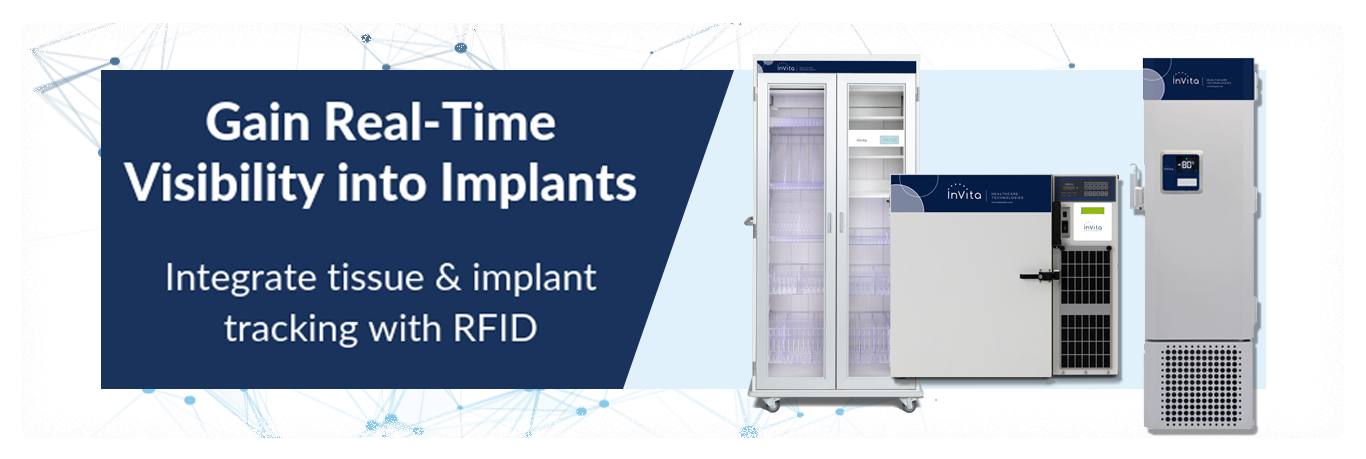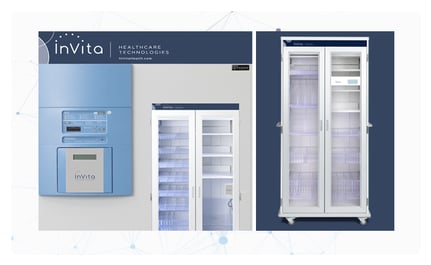
It was a pleasure to have Keith Hoffman, an RFID device expert with over 11 years' experience as Director of US Sales at Terso Solutions, join us for a Q&A session. Keith shared insights into how Terso Solutions and InVita Healthcare Technologies' collaboration enables healthcare organizations to achieve end-to-end control over their tissue and implant chain of custody and extends the boundary for visibility.
Discover why hospitals invest in tissue and implant tracking software and RFID cabinets to ensure compliance, improve clinical workflows, and achieve full transparency.

As the healthcare industry faces uncertain times, it is imperative that organizations monitor all inventory management processes. Combining our two solutions for identifying, monitoring, and managing inventory allows hospitals and health systems to gain a comprehensive view of their facilities at any given moment, enabling end-to-end control over their chain of custody, and compliance, with regulatory agencies. A fully connected smart system is essential for optimal inventory management.
Due to cross-departmental requirements, hospitals are finding it increasingly difficult to meet demands, control costs, and comply with regulations. In today's world, supply chain managers are constantly pressed to reduce costs and improve efficiency, but when your inventory management relies on siloed data from multiple sources, it is challenging to quantify.
Who doesn’t get frustrated from ordering online only to find out later that the item is out of stock?

Hospitals are no different. The need to read inventory levels accurately is a big problem. Trusting unreliable data and having a lack of visibility leads to shortages, stockouts and waste.
Hospitals benefit most from analyzing their product usage against order frequency. Traditional methods such as paper-based systems make it difficult to identify how much of a particular item is ordered and how much is used in a given timeframe.
The key to managing inventory effectively is having the right tools. It's critical to know where your inventory is at all times. The data collected from our RFID devices is fed into InVita's software, which provides live inventory tracking, allowing hospitals to monitor tissue and implant inventory levels in real time. By analyzing data from a fully connected system, strategic planning, forecasting, and cost savings can be achieved.

I have spent enough time in hospitals to know that traditional paper-based methods of tracking tissues, implants, and medical devices require an excessive amount of manual processes. Nursing teams spend too much time on tasks that aren't core to their job and are distracted from patient care. They're chasing boxes, worrying about expiration dates, entering data, scanning barcodes, and relabeling items, which leads to errors and delays. As hospital staffing shortages continue, automating these processes on the backend will make it easier for short-staffed workers to accomplish these tasks, which would increase efficiency.
Terso’s RFID enclosures are used by nurses in hospitals every day. As data flows into InVita's software for analysis, hospitals can simplify operations and rebalance staff workloads. Automation allows nurses to devote more time to patients. While barcode scanning still involves some manual work, the combination of RFID devices and software automate the entire process. Streamlining manual processes reduces errors and mistakes. Investing in our combined technology ensures minimal disruption. Having reliable data allows supply chain managers to make informed decisions.
Supply chain integrity defines how tissues and biologics are received, stored, and distributed. There must be certainty at every stage. This process starts upon receipt, and tracks when products are entered and removed from our RFID enclosures.
Identifying problems in advance is the key. In many facilities, alerts are connected to backend alarm systems, making their processes more reactive. As materials cannot withstand drastic temperature fluctuations, they must be monitored continuously, which can lead to unreliable, error-prone, and time-consuming processes. Through InVita's software, facilities are now able to alert users to errors and monitor these situations remotely. Terso's cabinets come equipped with sensors that provide real-time visibility, making it easier to manage sensitive products and to comply with standards established by regulatory agencies such as the FDA and the Joint Commission.
Managing environmental conditions effectively reduces waste and eliminates in-person inventory temperature checks.
Visibility is challenging for hospitals. Managing inventory effectively requires real-time data analytics. The ability to see data is useful, but the ability to act on it is even more valuable. In a climate where hospitals are under financial pressure and budget-conscious, providing tools to reduce spending, avoid shortages, and prevent unnecessary waste can help free up resources to be used elsewhere.
Addressing gaps in data prevents disruptions in the chain of custody. An IDN system-wide approach involves RFID, IoT sensors, cloud-based software platforms, and analytical tools working together in an environment where sensors acquire data and software transforms that data into actionable insights.
InVita's Implant360 combines all these analyses across multiple facilities. Besides identifying potential shortages, hospitals can monitor usage rates against inventory in real time. The same applies to expiration dates. Items that are close to expiring may be used or returned if stakeholders receive the information fast enough to act.
IDN system-wide visibility of inventory can be achieved by nesting all these elements together. Terso's RFID devices automatically add or subtract inventory in real-time, ensuring maximum accuracy. Repositioning inventory between hospitals is cost-effective when inventory counts can be relied upon. When another facility needs to locate an item quickly, knowing which items are located on which floors within the hospital network is essential.
Analytical quality also plays a significant role. It is imperative to have software that can analyze vast amounts of data quickly, integrated with manufacturers and device makers, and accessible at the point of care. A standardized open system enables accurate data exchange. A real-time view is possible as a result of everything being connected and automated. The significance of data analysis, interpretation, and application lies beyond counting inventory quantities.

Supply chain management is an integral part of the healthcare chain of custody. The number of material handling activities, episode delivery, retrieval cycles, and configuration changes makes this process more challenging.
Maintaining a close eye on what is entering the supply chain is the first step to maximizing the efficiency of high-value products. Advance shipment notifications alert affiliations immediately so they can prepare for the shipment. InVita's UDI tracking software integrates with manufacturers to communicate the transport process for suppliers to loading docks. The items are then scanned and stored in the appropriate locations. There are many hospitals that invest in high-quality cabinets, but still monitor those systems manually. Together, these tools provide the most comprehensive picture of the flow of products within a hospital network.
As hospitals and health systems face financial constraints, they are seeking ways to improve efficiency. When inventory is handled manually it becomes outdated quickly. The uncertainty in inventory counts leads to excess ordering, and the inability to detect expiration dates fast enough to prevent waste and write-offs.
The simplest way to reduce spend, waste, and free up cash is to manage inventory properly. Real-time inventory information allows stakeholders to adjust operations accordingly. Terso's devices combined with InVita’s software ensure that you only purchase what you need. By knowing what you have on hand, you will be able to prevent overstocking. The information you need about the product and its sizes is right at your fingertips. Our two systems work together to facilitate rapid, reliable, and easy data exchange. In other words, the result is a reduction in cost or an increase in cash flow available to spend elsewhere.
We just heard Keith Hoffman discuss the importance of inventory management processes capturing the lifecycle-end-to-end control where executives, supply chain managers, and clinical teams can manage the system proactively and acquire actionable insights that inform their decisions.
Together, Terso Solutions and InVita Healthcare Technologies provide hospitals with true chain of custody control by extending the boundaries of visibility.